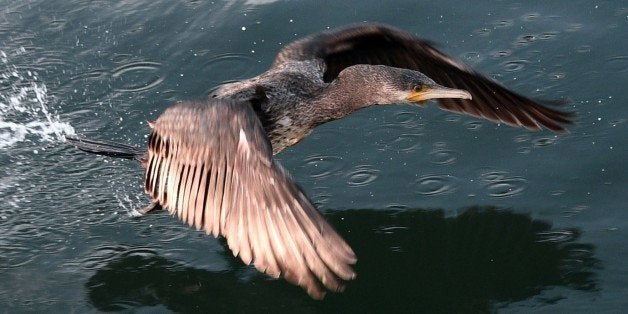
In August 2014 I wrote an essay called "Birds and Us: Should Cormorants Be Killed to Save Salmon?" in response to Felicity Barringer's essay in the New York Times called "Taking Up Arms Where Birds Feast on Buffet of Salmon." Ms. Barringer's essay dealt with the situation in Oregon's Columbia River where salmon living in the river were killed off due to hydroelectric dams, and are now increasing in number. Double-crested cormorants, who like to eat salmon, have become aware of this and are a threat to the fish. Many people, including conservation biologists, now say: "Shoot the birds." Others, such as the National Audubon Society's Stan Senner, argue that killing some of the birds who make up 25 percent of the birds' western population "is an extreme measure, totally inappropriate." Mr. Senner said "it was possible to shoo them away, noting 'They came from somewhere else. They can go back to somewhere else.'" He also notes, "We're not persuaded they have fully explored ways of improving habitats elsewhere, or other means of dispersing" these birds.
I thoroughly agreed with Mr. Stenner that the cormorants shouldn't be shot. The guiding principle of compassionate conservation (see also) is "first do no harm," which means the life of each and every individual animal is valued. So, trading off individuals of one species for the good of individuals of another species, or of the same species, isn't acceptable. I also agree with retired marine biologist Bob Hees, who is quoted as saying, "I've seen people try to mess with Mother Nature before, and it never works. It goes toward creating more problems." The cormorant-salmon situation is a good catalyst for open discussions about creating a viable and practical conservation ethic based on compassion.
There will be blood: Experimental killing sprees are wrong and likely won't work.
Despite experts agreeing that killing the cormorants is wrong and won't work, it turns out that the U.S. Army Corps of Engineers is planning to kill nearly 11,000 cormorants and destroy more than 26,000 of their nests to try to reduce cormorant numbers by more than half. You can read the details in an essay by Alicia Graef called "Plans Move Forward to Kill Thousands of Cormorants."
Ms. Graef also notes:
Criticism [to the killing spree] was also brought by researchers from Oregon State University who were hired by the Army Corps to study the bird population on the island. They say the Army Corps ignored their findings and isn't using the best available science in its plan to protect young salmon.
Unfortunately, despite widespread opposition from the public and scientific community, the Army Corps announced it has finalized its decision that will slightly reduce the number of cormorants targeted, but will still kill nearly 11,000 of them and destroy more than 26,000 of their nests in an effort to reduce their numbers by more than half.
Killing one species to save another is a rather common occurrence and I also wrote about this heinous practice in an essay called "Killing Barred Owls to Save Spotted Owls? Let's Stop Bloody Conservation Practices." In this piece, I wrote about an essay in the magazine Conservation by science writer Warren Cornwall called "There Will Be Blood," and noted that it is a must read for anyone interested in keeping up with current discussions and debates about the supposed need to kill animals of one species to save those of another species. The question at hand in Mr. Cornwall's excellent essay is, "Should barred owls be killed to save endangered spotted owls?" Spotted owls are shy birds who favor ancient forests that are disappearing due to logging in the northwestern United States, and they are threatened by larger and more aggressive barred owls who have migrated west from their original homes on the east coast of the United States.
Killing one species to save another isn't a "sad good," it's wrong.
At the beginning of his piece Mr. Cornwall writes, "The pressure to reach for a gun to help save one animal from another is stronger than ever. And it has triggered a conservation problem from hell." He's right. I argued against killing the barred owls and against the position of ethicist, Bill Lynn. Dr. Lynn was hired by the Fish and Wildlife Service, and was initially skeptical about the above killing experiments, however, he changed his mind. He concluded that it was all right to kill the barred owls as an experiment if it was done as humanely as possible, and called it a "sad good."
For me, a "sad good" is a very slippery slope that sets a lamentable precedent for opening the door for the more widespread "experimental killing" of barred owls and other species. Dr. Lynn balked on supporting a region-wide war on barred owls, and, experts protested any killing because they were convinced it simply wouldn't work.
The killing of the cormorants is really a murderous experiment, and is wrong and likely won't work. Even if it did "work," whatever that means, according to Ms. Graef:
The Audubon Society of Portland announced its Board of Directors has voted to sue both the Army Corps and the FWS if permits are granted. Bob Sallinger, the organization's conservation director, said in a statement (link is external):
'We are deeply disappointed that despite more than 145,000 comments opposing this decision, the federal government has chosen to move forward with the wanton slaughter of thousands of protected birds. Rather than addressing the primary cause of salmon decline, the manner in which the Corps operates the Columbia River Hydropower System, the Corps has instead decided to scapegoat wild birds and pursue a slaughter of historic proportions.
Sadly this will do little or nothing to protect wild salmon but it will put Double-crested Cormorant populations in real jeopardy. The organization is hoping to get the Army Corps to focus instead on non-lethal measures that will protect both birds and salmon. For more info on how to help protect these cormorants from being needlessly killed, visit the Audubon Society of Portland.'
Please do all you can to stop this unnecessary slaughter.
This post originally appeared on Psychology Today.
